A few reasons we're obsessed with Iceland: Elves, the Northern Lights, canyons, puffins, waterfalls, glaciers, long-haired ponies...
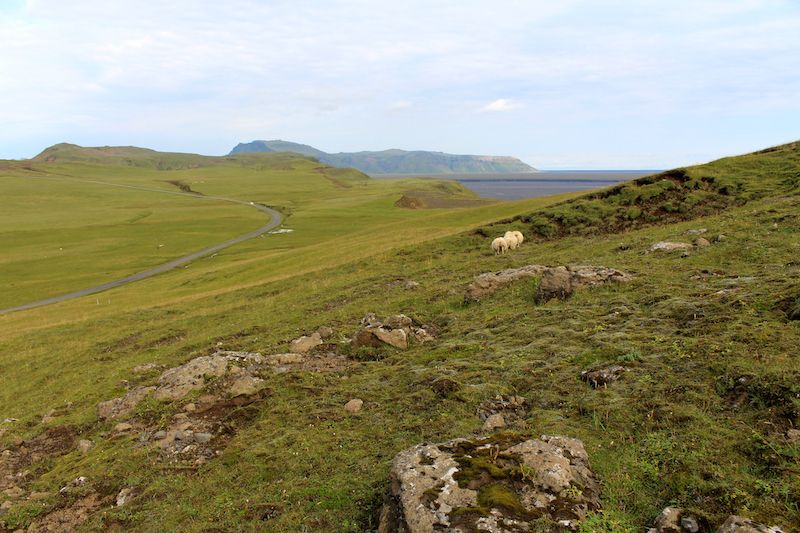
The first mistake I made in packing for my weeklong trip to Iceland was the number of books I brought. By my logic, the Ring Road, an 840-mile highway that skirts the entire coast of Iceland would take roughly 16 hours, which factored into 3 books to pass the time between each stopping point. What I didn’t account for is that Iceland is—and really, there’s no delicate way to put this—painfully magical. As soon as you pull yourself away from the waterfall you discovered in a secluded cave, you’ll head straight into the most beautiful rainbow you’ve ever seen, framing a sheep-dotted cliff with the largest glacier south of the Arctic circle cresting the horizon. There’s probably a puffin or pony cavorting somewhere in the distance. This is how it is for the entire drive. I didn’t read any books.
During the drive around the Ring Road with my two travel companions, I gave up on counting the daily waterfalls we passed (I don’t think we went 10 minutes without seeing one), swam in a hot spring, stood in the splash zone of several waterfalls, enjoyed daylight until 9 P.M., and saw the Northern lights. It’s no wonder 40% of Icelanders believe in elves—how else do you explain the country’s disproportionate allotment of natural beauty? For a country the size of Kentucky, it packs a punch. Here are some of my favorite spots I visited in Reykjavik and along the Ring Road:
Reykjavik
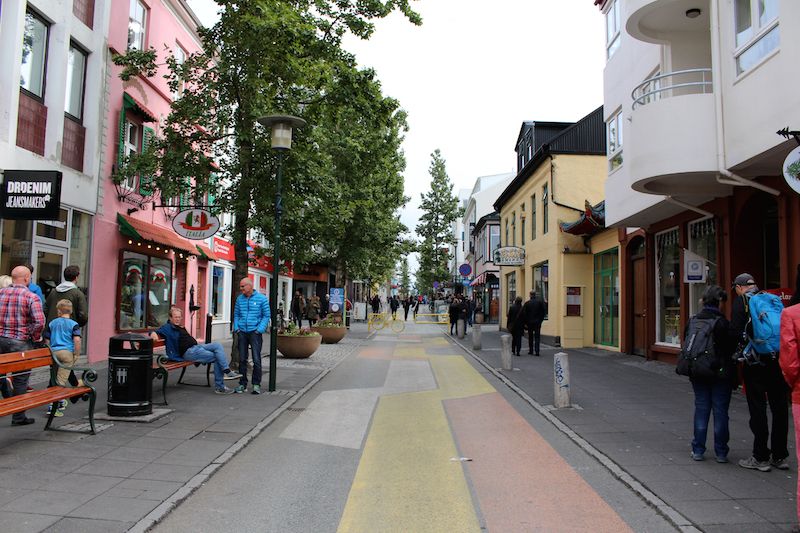
Some of the best advice we received before leaving on our trip was to only spend two full days in Reykjavik—the city, while home to some interesting restaurants and a neverending supply of Scandinavian design stores, is extremely small. It takes about 15 minutes to walk from one end of downtown to the harbor.
The Blue Lagoon: The milky-blue waters of the Blue Lagoon, supplied by natural runoff from the nearby geothermal energy plant, are a popular tourist attraction halfway between the airport and the city of Reykjavik. A day pass will give you access to the enormous man-made lagoon that differentiates itself from the average public pool by its tubs of natural silica (which can be used as a face mask), saunas, and waterfalls. If you have long hair, just be sure to keep it up, because while the silica is good for your skin, it can irreversibly damage your locks.
While wading through the chest-deep water, look out for the Icelandic women carrying trays of the Blue Lagoon’s line of silica products—they’re a wealth of information. One woman explained that they couldn’t build the expansion to the Blue Lagoon (which includes plans for a five-star hotel) until the president of Iceland hand-delivered the building plans to the lava-dwelling elves.


Left: An ominously-named design store tucked into a side alley with hand-drawn maps. Right: Whimsical paperweights at Aurum.
Design stores: Downtown Reykjavik is a haven for unbelievably cute design stores, which you could easily spend a day perusing. Some of the highlights include Aurum, a great place to buy kids’ toys and delicate, handcut mobiles; Foa, home to non-cheesy, touristy gifts, like Ninna Thorarinsdottir’s line of cheeky, illustrated postcards; Hrím and Hrím Eldus, which has a large assortment of beautiful ceramics and an adjacent kitchen store that I had to walk out of for fear of buying an entire set of Icelandic pots; Dead, a gothic store with an assortment of hand-drawn maps of Iceland; and Spark, which carries some children’s clothes and printed, colorful maps of the country.
Coffee and quick bites: While artisanal coffee and espresso is still a relatively new addition to Iceland, it’s taken off—there are several per block of downtown’s main walking street, Laugavegur. After trying several (jet lag is a cruel mistress), Mokka, a dim coffee shop housed in a cozy, dark wood gallery, won several times over for its Swiss Mocha, an espresso topped with hot chocolate and whipped cream, while Sandholt had the best baked goods.
For a quick lunch, head to the hot dog stand near the harbor, Baejarins Beztu Pylsur for a classic Icelandic hot dog: a lamb, beef, and pork dog placed atop a bed of both raw and fried onions, topped with pylsusinnep (a sweet brown mustard), remoulade (a Scandinavian mayonnaise and relish condiment), and ketchup. Or go for “The Clinton,” which just has mustard, just like Bill had on his visit.
For a classic Icelandic snack, head into the fish market—it's inside of the flea market in a huge warehouse on the harbor—where you can find dried, salted cod with butter (think of it as fish jerky, topped with butter) or, if you dare, try the hákarl. Bluntly put, hákarl is fermented shark (aged in soil for up to 16 weeks), which was notoriously declared by Anthony Bourdain to be the worst thing he’s ever eaten. While traditionally chased by Brennivín, an Icelandic brand of schnapps, in the fish market, it’s served to unsuspecting tourists in bite-sized samples off of plastic plates. All I can tell you is that I still shudder at the thought (“putrified” comes to mind as the primary descriptor) and Post-Traumatic Hákaral Disorder is a real thing. If you make the same mistake I did, head further down the harbor to Fish and Chips to remind yourself that not all Icelandic fish products are terrible.
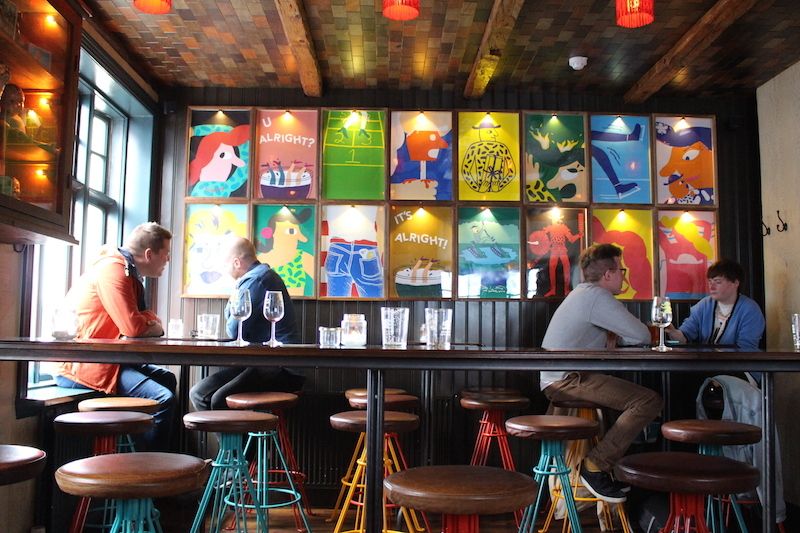
The Mikkeller bar in downtown Reykjavik is decorated with illustrations by Keith Shore.
Restaurants: At first glance, most of the restaurants in downtown Reykjavik are almost impossible to differentiate—most places have some sort of lamb and potatoes dish, several fish dishes, and a high proportion of hamburgers (all of which come at a hefty price tag). But there are a few standout places: Under the Mikkeller bar, which is worth visiting for its selection of draft Spontan beers, is an unnamed pizza place that, despite its marquee attraction, serves several traditional Icelandic starters.
Fiskmarkadurinn (Fish Market) is an upscale restaurant that serves puffin and an array of seafood including arctic char and salmon, and Snaps is an adorable French bistro on the corner of a residential street just off the main walking street that serves a twist on traditional Scandinavian smørrebrød, piled high with shrimp, pork belly, or seasonal vegetables. The tasting menu at Dill though, Iceland’s only Michelin-starred restaurant by Gunnar Karl Gislason, the author of North, was the city’s highlight.
The Golden Circle and Southwest Iceland

A roughly two-hour loop of four scenic attractions just east of Reykyavik, the Golden Circle is an abridged version of the Ring Road that can easily be done in half a day if you need to keep your trip to Iceland short.
Scuba or snorkel between the North American and Eurasian tectonic plates: This is the only place in the world where a mid-ocean ridge of divergent tectonic plates appears on land, but you’d never know it looking over the unassuming lagoon in Thingvellir, the national park. All of the action happens underwater, but can be seen by snorkeling or scuba diving (in appropriate gear—the water is barely above freezing!). Once underwater, you can swim between the two tectonic plates, which separate into a nearly endless fissure where new crust is created every day, causing the plates to move apart up to 2 centimeters every year. The chilly water is worth the view.
Visit the Gullfoss waterfall: Named for the golden light that reflects off of it during sunset, this waterfall has two ninety-degree falls that combine into one that’s viewable from the observation deck directly opposite it.
See the original geyser: One of the most popular attractions along the Golden Circle is Geysir, which is also the source of the English word. This one no longer spouts, but follow the crowds of people to Strokkur, which erupts dramatically about every 10 minutes—just don’t stand downwind of it.
Hike around the Kerid crater (pictured above): Once a volcano that caved in on itself and filled with magma, it now holds a lake at the center of its crater. Walk along its rim, then follow the quick, 100-meter trail down to the water’s edge.
The Sights to See on the South Coast
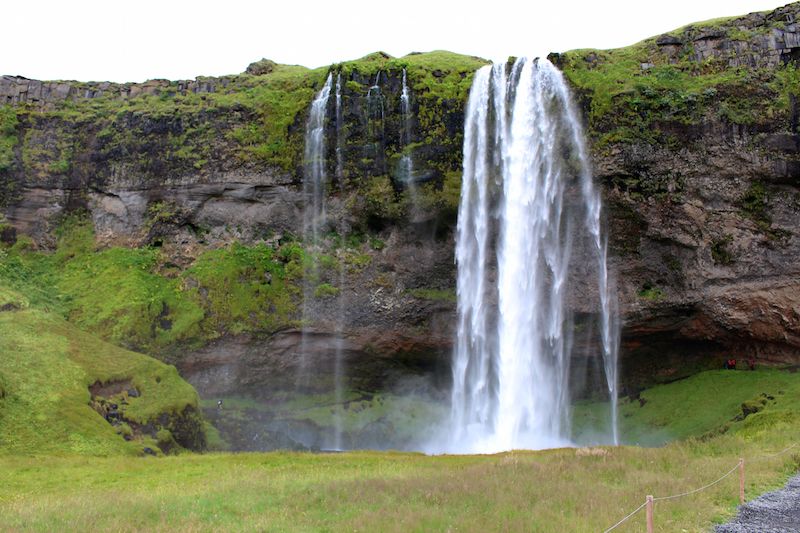
The South Coast is where most of the Ring Road action is—think endless canyons and ever-changing scenery, from rolling hills to steep basalt cliffs, with an enormous glacier. And sheep, everywhere.
Seljalandsfoss: The first waterfall (pictured above) that you come to along the Ring Road—of literally hundreds—is one of the most impressive. It cascades from nearly 60 meters into a small river, and while many of the waterfalls along the road have lookouts that are level with the top of the falls, this one is unique: You can stand from the bottom looking up, and even walk along a path that leads to a ledge behind the falls. One of the best parts, though, may be the lesserknown fall roughly 1 kilometer away that’s tucked inside of a cave—you would never know it’s there if you didn’t go inside. Once you do—and you should—you’ll find a fall that’s flooded with light from an opening at the top that looks like something out of a fairytale.
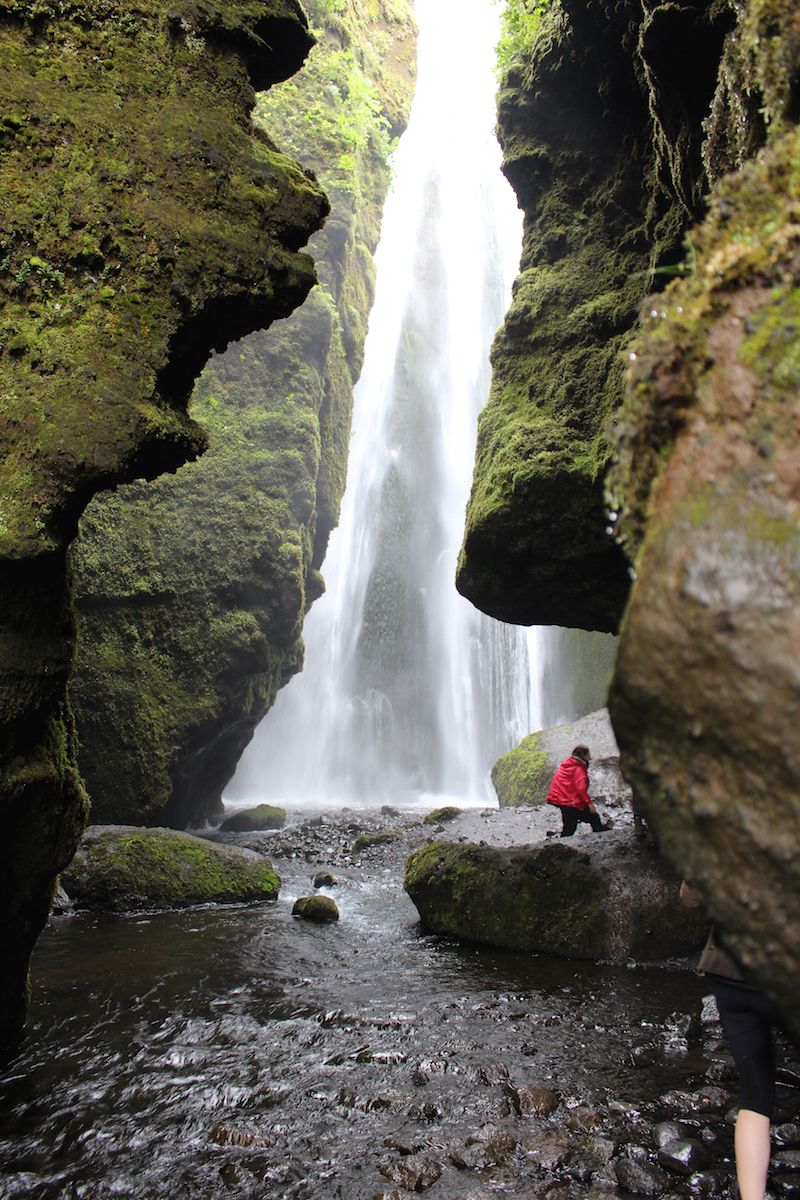
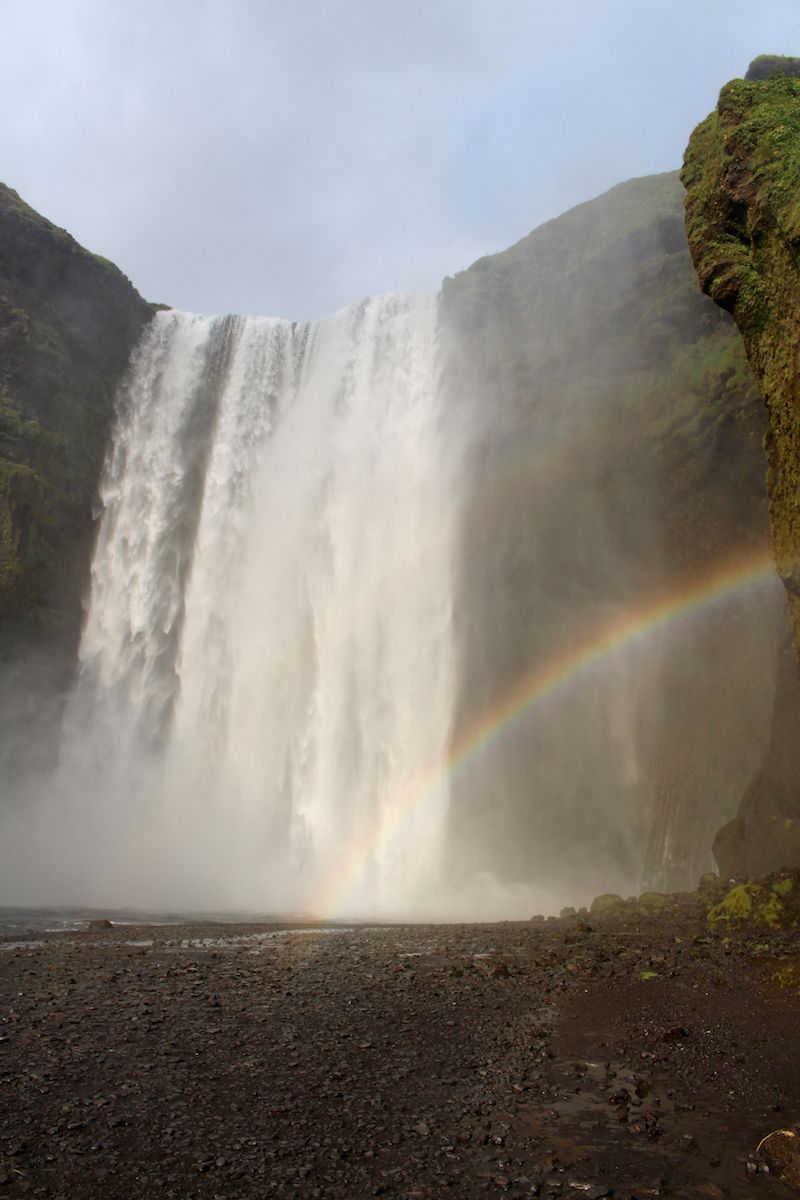
Left: Roughly 1 kilometer west of Seljalandsfoss is a waterfall completely hidden in a cave. Right: Skogafoss is beautiful, but it's what's at the top that's truly breath-taking.
Skogafoss: Like Seljalandsfoss, Skogafoss has a lookout from the bottom of the fall, which creates an impressive rainbow at some points in the day, but make sure you walk up the side of this fall. The daunting 400 steps, followed by a quick hop over a fence, lead to the most beautiful place I’ve ever seen: Above the waterfall is a rushing river with tapered plateaus of mini-waterfalls with moss-covered cliffs, plus small islands covered in trees and black sand beaches that look like their own microworlds. My advice: Take the stairs.
Dyrhólaey: Be sure to see these—they look over a basalt rock arch in the middle of the ocean formed thousands of years ago by an underwater explosion.
Vik: A tiny town (Population: 290) at the base of the glacier-covered volcano, Eyjafjallajökull (which was inspiration for the car game we invented, “Try to Pronounce Eyjafjallajökull”), Vik is surrounded by green hills. It’s also home to two restaurants (The Grill and The Bistro)—both of which are in the town’s center. Pro tip: If you plan to go for a run on Vik’s famous black sand beaches, just know that it may be cut short when you become distracted by watching the puffins do their morning fly into the ocean.
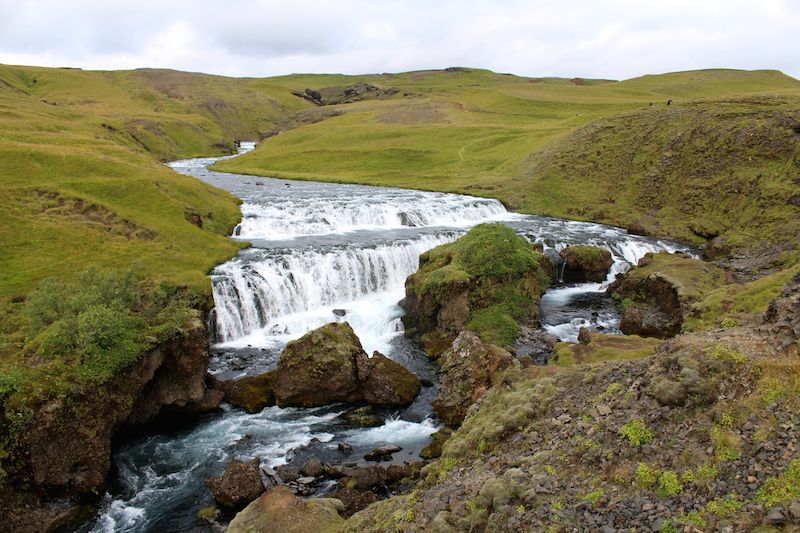
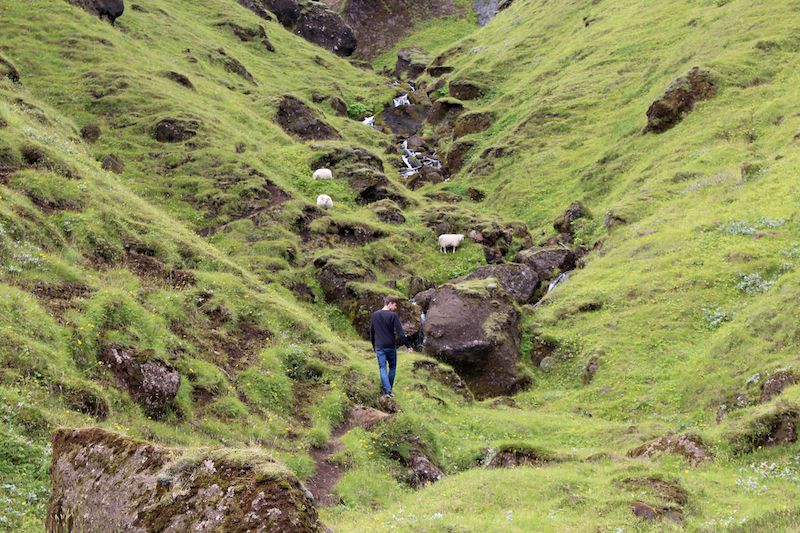
Left: The view from the top of Skogafoss. Right: Leslie's boyfriend follows sheep up a small stream at the Thakgil campground.
Thakgil campground at the end of dirt road 214: It didn’t take long for us to learn that when you have the option of taking a dirt road or a trail in Iceland, take it—it will inevitably lead you to yet another beautiful place. This road, a blip on our map which we decided to follow in the moment, took us through roughly 16 kilometers of rolling hills with sheep and dramatic cliffs, over black sand ravines carved out by glaciers, and ended at a campground at the base of a waterfall with sheep drinking from it. Like I said, magical.
Fjadrargljufur Canyon: Lined with sheer basalt columns covered in a thin layer of green, this canyon ends at a point where three waterfalls join into a pool.
Dverghamrar basalt columns outside of Kirkjubaejarklaustur: Said to be home to elvish royalty, these columns, which rise out of the middle of a field, have intricate rock forms that are almost beautiful enough to completely distract from the adorable town that serves as its backdrop.
The Sights to See on the Southeast and East Coast

The largest glacier in Iceland is visible along the horizon line for much of the drive in the South.
The East Coast is much less touristy than the South, but no less beautiful. It’s also the perfect place to spot the Northern lights since there’s hardly any light pollution—head outside around 11:30 P.M., look north on a clear night, and you might get lucky.
Skaftafell in Vatnajökull National Park: Home to the largest ice cap outside of the Arctic Circle, Vatnajökull contains both the lowest and highest point in Iceland—with an average thickness of 1,200 feet—that covers active volcanoes (which leads to huge glacial floods when they erupt). There are paths of various lengths, including one that that leads up to the base of the glacier.
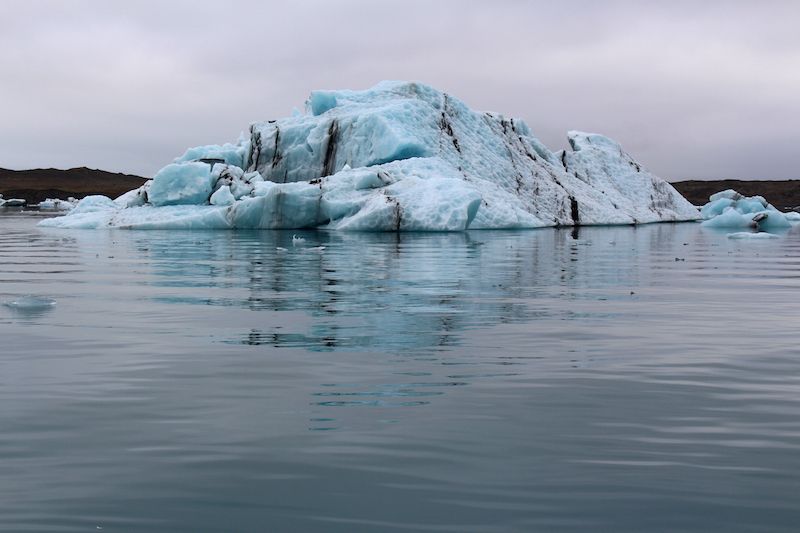
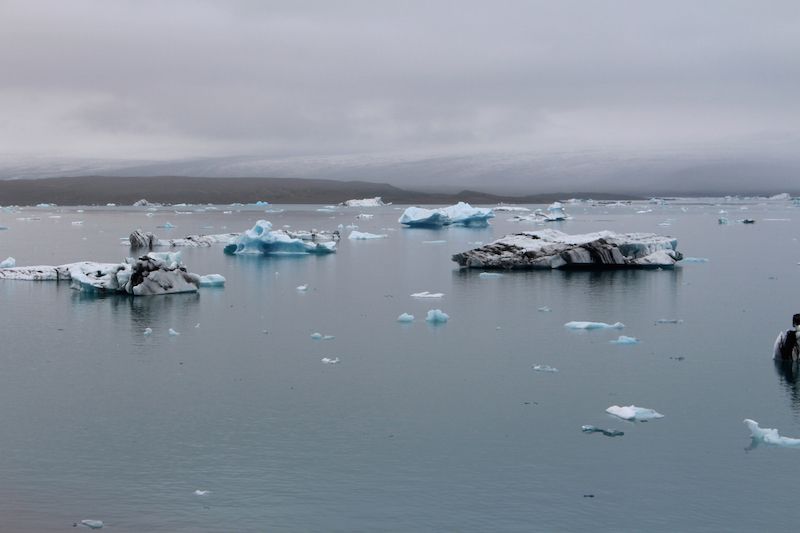
Jökulsárlón: Only 80 years old, Jökulsárlón, or the Glacier Lagoon, is the result of glacial melt. It’s now a lake that holds enormous icebergs that are floating to sea after they’ve fallen off the glacier. Seeing the enormous icebergs is magnificent; if you’re lucky, you can see one flip to maintain its 90% below water, 10% above ratio, and boat tours are available in the lagoon, but it’s just as striking from the shore as it is from the water.
The Sights to See on the North and West Coasts
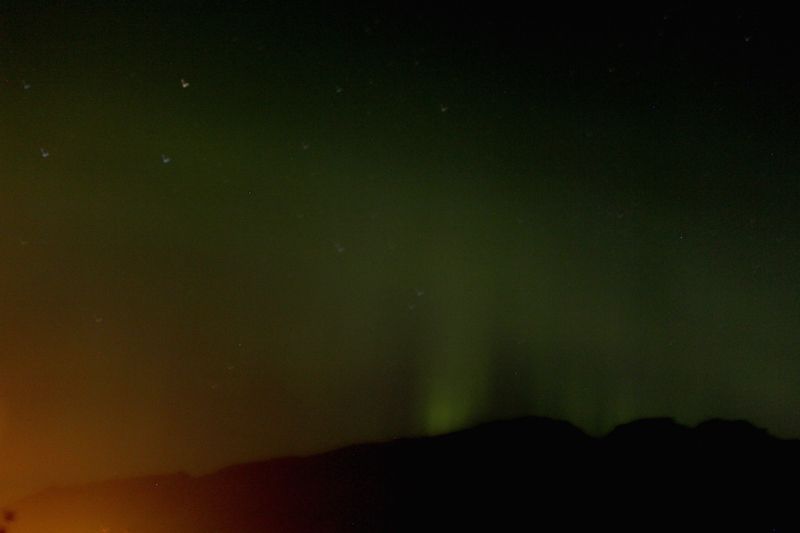
Dancing Northern Lights—visible from a cabin we stayed in—in the Northeast.
Home to the second largest city in Iceland, the North coast is slightly more populous than the East coast, and is just one degree south of the Arctic circle at some points. If you have time, make a detour to the Snæfellsnes Peninsula and Westfjords for more beautiful scenery and world-renowned bird watching.
Dettifoss: The most powerful waterfall in Europe, Dettifoss is among the widest along the Ring Road and resembles Niagra Falls in its girth. It also gives off tons of mist (this is incidentally where my camera, after being exposed to more than its fair share of waterfall mist, finally gave out).
Asbyrgi Canyon: According to myth, this U-shaped canyon is the result of a Nordic god’s horse’s hoof print. And that’s exactly what it looks like, with a base filled with trees and trails that lead to the top of the canyon.
Húsavík: This tiny town has fantastic whale watching. If you have the opportunity, stop for a bowl of fish stew at Naustid, which is one degree south of the Arctic Circle and has a view of mountains on the other side of the bay.
Lake Myvatn and Dimmuborgir: These dramatic rock forms and barren lake on the North Coast of Iceland have served as the background for several Game of Thrones episodes. It's no wonder—it really does look like a magical land in the middle of nowhere, with hot springs and a maze of lava caves (called Dimmuborgir) to boot.
Akureyri: This is the second largest city in Iceland—take a walk down its main street, which doesn’t have nearly as many shops as Reykjavik, but boasts its own style of Icelandic hot dog (all the fixins, plus pickled red cabbage).
Peninsula and Westfjords: While I didn’t have time to head out to the peninsula this trip, as it's a significant detour off of the Ring Road, it's highly recommended for its sheer cliffs and bird watching.
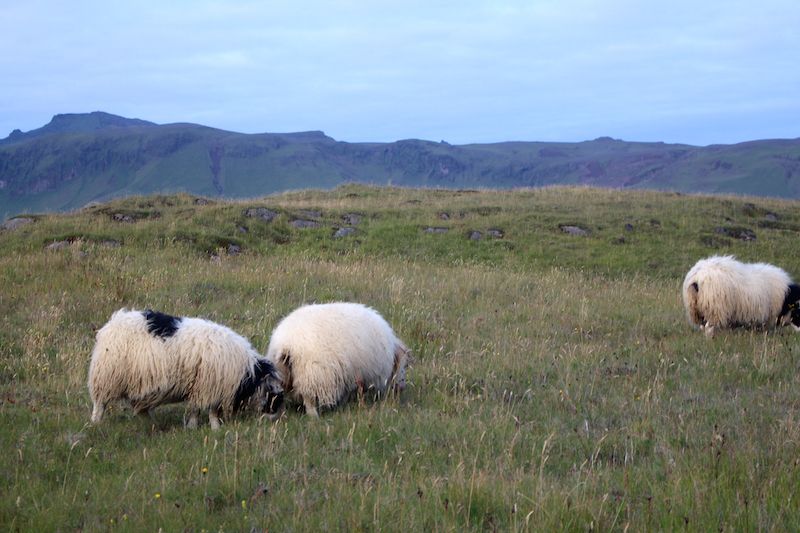
My Takeaways:
- Icelanders take their Skyr (a cheese with the consistency of a thick Greek yogurt) with heavy cream poured over top, which may forever change the way I eat yogurt.
- It’s colder than you think it will be, but there are a lot of hikes—so pack in layers and bring plenty of rain gear.
- One restaurant we visited in East Iceland had the longest list of Icelandic craft beers, which amounted to about five breweries: Gull and Viking are the two big players and make a pretty solid pilsner (I preferred Viking), Borg makes a great Imperial Stout, and Einstök, a brewery out of Akureyri, made decent versions of pilsner and white ale.
- Whether you believe in elves or not, it’s safe to err on the side of caution while in Iceland—if you insult the environment in any way, which is by extension their home, your family will be cursed for seven generations. In other words, don’t litter.
Have you ever been to Iceland? Do you believe in elves? Tell us in the comments below!

















See what other Food52 readers are saying.